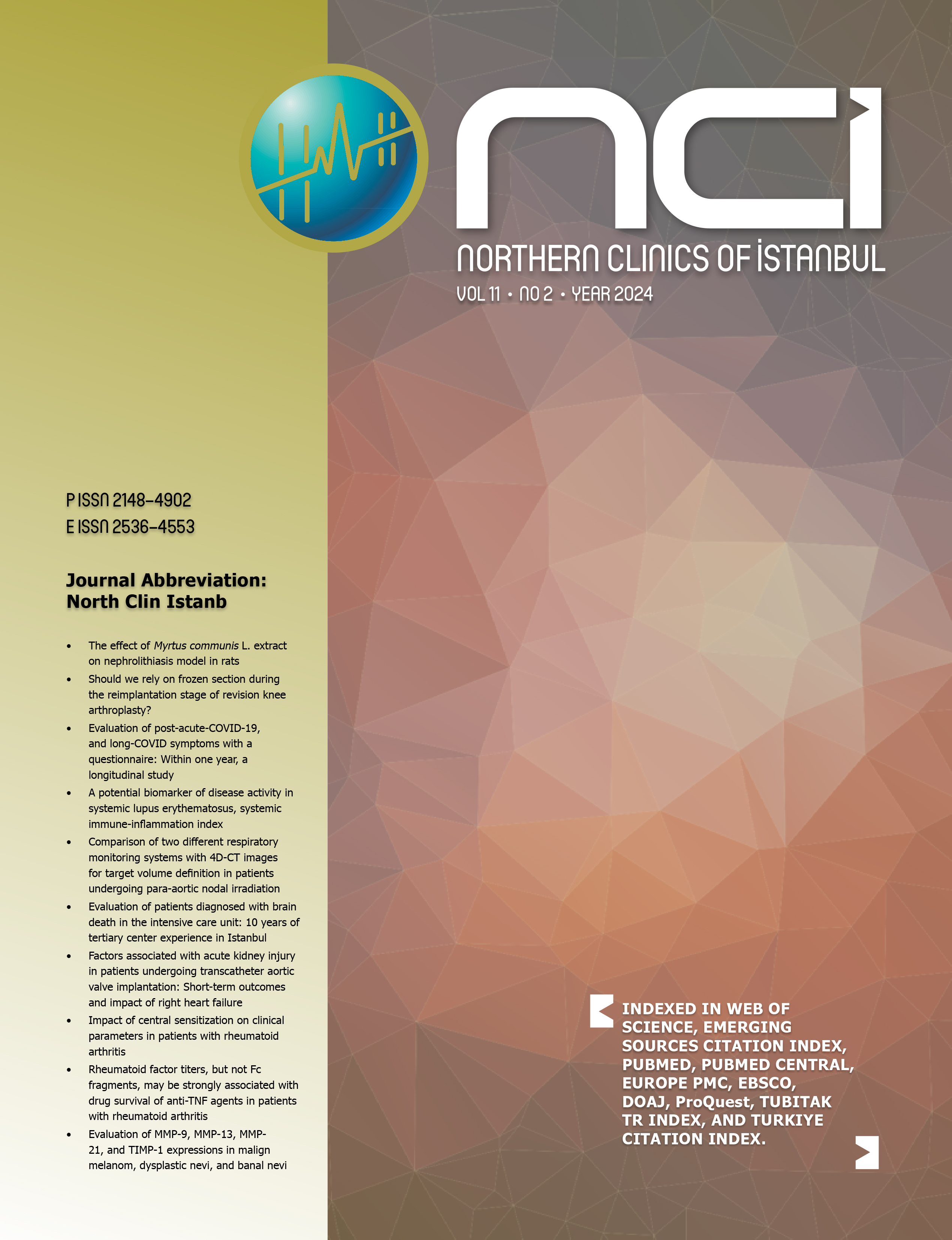Histopathological and molecular analysis in dermis and epidermis of patients with systemic and localized scleroderma
Betul Sozeri1, Seyma Turkmen1, Basak Yildiz Atikan2, Huseyin Aktug31Department of Pediatric Rheumatology, University of Health Sciences, Umraniye Training and Research Hospital, Istanbul, Turkiye2Department of Pediatrics, Ege University Faculty of Medicine, Izmir, Turkiye
3Department of Histology, Ege University Faculty of Medicine, Izmir, Turkiye
OBJECTIVE: Scleroderma has a wide range of clinical manifestations due to vasculopathy, autoimmunity, altered endothelium function, and abnormal fibrosis, which are accused in the pathogenesis of the disease. The aim of this study is to shed light on the pathogenesis of the disease in childhood via dermal immunohistochemical analysis of the cases.
METHODS: A single-blind clinical trial is conducted with evaluation of the tissue samples obtained from patients. The samples are stained with PAS, hematoxylin and eosin, E-Cadherin, Connective tissue growth factor (CTGF), Tunnel, and staining
for Transforming growth factor beta 1 (TGF-β1) and evaluated by light microscopy. In addition, both TGF-β1 level and mRNA expression analyses in plasma and tissue samples from patients are performed. A total of 15 patients (systemic, n=8 or localized; n=7) were enrolled in the study.
RESULTS: The mean age of onset of the disease was 9.2±1.2 years, and the mean age of diagnosis was 15.3±3.2 years. Antinuclear antibody (ANA) titer was between 1/1601/640 in all patients with systemic sclerosis. There was no ANA positivity in patients with localized scleroderma. A total of 22 tissue samples (15 diseased tissues, 7 healthy tissues) were examined. Histopathological examination has shown that two clinically different subgroups have different characteristics at the tissue level.
CONCLUSION: TGF-β1 levels, which play a fundamental role in the pathogenesis of the disease, are found in both plasma and skin have been shown high. This elevation was found particularly in patients with systemic scleroderma to be more pronounced. Also, in patients with localized scleroderma, skin fibroblasts have been shown to limit the pathologic response.
Keywords: Childhood; scleroderma; transforming growth factor beta 1.
Sistemik ve lokalize skleroderma hastalarında dermis ve epidermisin histopatolojik ve moleküler analizi
Betul Sozeri1, Seyma Turkmen1, Basak Yildiz Atikan2, Huseyin Aktug31Sağlık Bilimleri Üniversitesi, Ümraniye Eğitim ve Araştırma Hastanesi, Çocuk Romatoloji Kliniği, İstanbul2Ege Üniversitesi Tıp Fakültesi, Çocuk Sağlığı ve Hastalıkları Anabilim Dalı, İzmir
3Ege Üniversitesi Tıp Fakültesi, Histoloji Anabilim Dalı, İzmir
Amaç: Skleroderma, hastalığın patogenezinde suçlanan vaskülopati, otoimmünite, bozulmuş endotel fonksiyonu ve anormal fibrozis nedeniyle geniş bir klinik tabloya sahiptir. Bu çalışmanın amacı olguların dermal immünohistokimyasal analizi ile çocukluk çağında hastalığın patogenezine ışık tutmaktır.
Method: Hastalardan alınan doku örneklerinin değerlendirilmesiyle tek kör bir klinik çalışma yürütüldü. Örnekler PAS, hematoksilen - eozin, E-Cadherin, bağ dokusu büyüme faktörü (CTGF), Tunnel ile boyandı ve Transforming growth faktör beta 1 (TGF-β1) boyaması yapıldı. Işık mikroskobu ile değerlendirildi. Ayrıca hastalardan alınan plazma ve doku örneklerinde hem TGF-β1 düzeyi hem de mRNA ekspresyon analizleri yapıldı. Çalışmaya toplam 15 hasta (sistemik, n=8 ve localize, n=7) dahil edildi.
Bulgular: Hastalığın ortalama başlangıç yaşı 9.2±1.2 yıl, ortalama tanı yaşı ise 15.3±3.2 yıldı. Sistemik sklerozlu hastaların tamamında anti nükleer antikor (ANA) titresi 1/160-1/640 arasında idi. Lokalize sklerodermalı hastalarda ANA pozitifliği yoktu. Toplam 22 doku örneği (15 hastalıklı doku, 7 sağlıklı doku) incelendi. Histopatolojik incelemede, klinik olarak farklı iki alt grubun doku düzeyinde de farklı özelliklere sahip olduğu gösterilmiştir.
Sonuç: Hastalığın patogenezinde temel rol oynayan TGF-β1 düzeylerinin hem plazmada hem de deride yüksek olduğu gösterilmiştir. Bu yükselmenin özellikle sistemik sklerodermalı hastalarda daha belirgin olduğu görüldü. Ayrıca lokalize sklerodermalı hastalarda deri fibroblastlarının patolojik yanıtı sınırladığı gösterilmiştir. (NCI-2023-11-11)
Anahtar Kelimeler: Çocukluk çağı; skleroderma; transforming growth faktör beta 1.
Manuscript Language: English





















